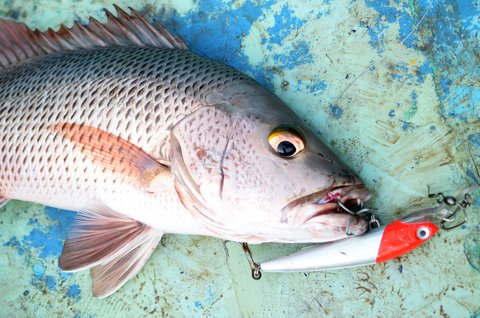
How many times have you tossed your favorite lure out over the water and started retrieving it, only to discover the bait is not running deep enough to reach the fish? If it happens regularly, you are not alone.
Artificial lures may have the right action, shape and color to attract fish, but they are not always heavy enough to run at the correct depth. The solution is simple: Add some weight to improve lure performance. But many anglers are either afraid to alter their expensive lures or unsure how to effectively add weight.
There are numerous methods of adding weight to a lure; some are permanent, while others are temporary. Either solution results in a lure that runs at a level where it can trigger a strike.
If you own a lure that consistently runs too shallow, one of the permanent solutions may be a better choice.
For hollow plastic lures, drill a hole in the belly of the bait, fill it with vegetable oil and then seal the hole with a waterproof caulk. You might have to experiment with different amounts of oil to find the weight that works best for a particular lure.
For wooden lures, try drilling a shallow hole - the width and depth of a split-shot sinker - in the underside of the lure; then glue a sinker in the hole with epoxy glue. Positioning of the weight is crucial. Keep the weight near the bait’s center of gravity. If it is too far forward or back, it could dramatically affect the lure’s action. Before drilling a hole try taping weights to the lure at different locations to see how the weight affects the bait’s motion.
Another solution for wooden lures is one of the commercially available weight systems. You still have to drill into the lure to use a weight system, but it allows you to easily change the size of the weight. In recent years, lure manufacturers also have introduced lures that are sold with weight systems, which are convenient alternatives to do-it-yourself modifications.
For a temporary weight solution, try wrapping lead wire or soldering wire around the shanks of the lure’s hooks. The lead wire available for fly tying works well, because it is readily available at any fly-tying shop and it comes in a variety of weights.
A few manufacturers are offering weighted tape, which is stuck to the bait to achieve the correct weight. It’s easy to apply and remove. It also makes it easy to adjust the weight so it is positioned properly on the lure.
No matter what method you use to add weight, chances are good it will affect the bait’s action to some extent, but this is not necessarily a bad thing. The change in action could be the added extra that entices a strike.
The problem of lures and weight is nothing new, but anglers who embrace one of the many solutions, bring themselves one step closer to catching fish.








